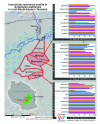Fine-scale spatial and temporal heterogeneities in insecticide resistance profiles of the malaria vector, Anopheles arabiensis in rural south-eastern Tanzania
- PMID: 29417094
- PMCID: PMC5782413
- DOI: 10.12688/wellcomeopenres.12617.1
Fine-scale spatial and temporal heterogeneities in insecticide resistance profiles of the malaria vector, Anopheles arabiensis in rural south-eastern Tanzania
Abstract
Background: Programmatic monitoring of insecticide resistance in disease vectors is mostly done on a large scale, often focusing on differences between districts, regions or countries. However, local heterogeneities in residual malaria transmission imply the need for finer-scale data. This study reports small-scale variations of insecticide susceptibility in Anopheles arabiensis between three neighbouring villages across two seasons in Tanzania, where insecticidal bed nets are extensively used, but malaria transmission persists. Methods: WHO insecticide susceptibility assays were conducted on female and male An. arabiensis from three proximal villages, Minepa, Lupiro, and Mavimba, during dry (June-December 2015) and wet (January-May 2016) seasons. Adults emerging from wild-collected larvae were exposed to 0.05% lambda-cyhalothrin, 0.05% deltamethrin, 0.75% permethrin, 4% DDT, 4% dieldrin, 0.1% bendiocarb, 0.1% propoxur, 0.25% pirimiphos-methyl and 5% malathion. A hydrolysis probe assay was used to screen for L1014F ( kdr-w) and L1014S ( kdr-e) mutations in specimens resistant to DDT or pyrethroids. Synergist assays using piperonly butoxide (PBO) and triphenol phosphate (TPP) were done to assess pyrethroid and bendiocarb resistance phenotypes. Results: There were clear seasonal and spatial fluctuations in phenotypic resistance status in An. arabiensis to pyrethroids, DDT and bendiocarb. Pre-exposure to PBO and TPP, resulted in lower knockdown rates and higher mortalities against pyrethroids and bendiocarb, compared to tests without the synergists. Neither L1014F nor L1014S mutations were detected. Conclusions: This study confirmed the presence of pyrethroid resistance in An. arabiensis and showed small-scale differences in resistance levels between the villages, and between seasons. Substantial, though incomplete, reversal of pyrethroid and bendiocarb resistance following pre-exposure to PBO and TPP, and absence of kdr alleles suggest involvement of P450 monooxygenases and esterases in the resistant phenotypes. We recommend, for effective resistance management, further bioassays to quantify the strength of resistance, and both biochemical and molecular analysis to elucidate specific enzymes responsible in resistance.
Keywords: Anopheles arabiensis; Spatial and temporal variations; Tanzania; insecticide resistance; kdr detection; malaria control; metabolic resistance.
Conflict of interest statement
Competing interests: No competing interests were disclosed.
Figures
References
-
- West PA, Protopopoff N, Wright A, et al. : Indoor residual spraying in combination with insecticide-treated nets compared to insecticide-treated nets alone for protection against malaria: a cluster randomised trial in Tanzania. PLoS Med. 2014;11(4):e1001630. 10.1371/journal.pmed.1001630 - DOI - PMC - PubMed
Grants and funding
LinkOut - more resources
Full Text Sources
Other Literature Sources
Molecular Biology Databases
Miscellaneous


